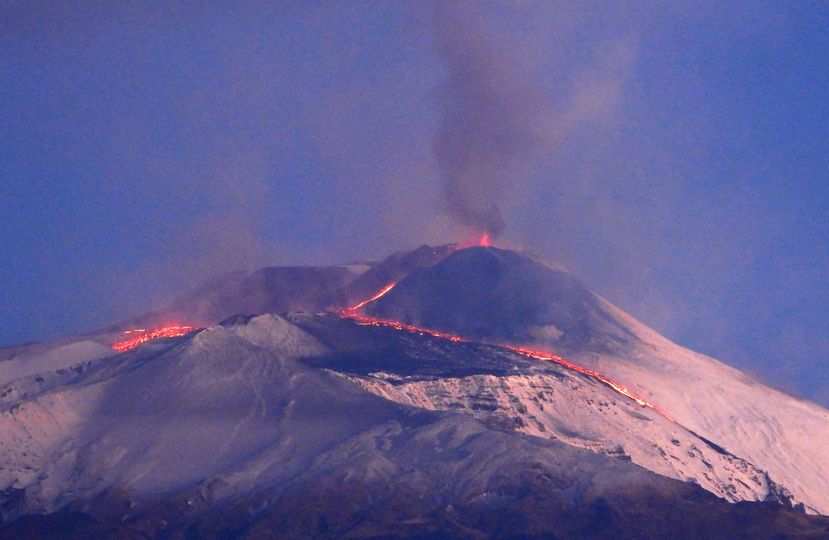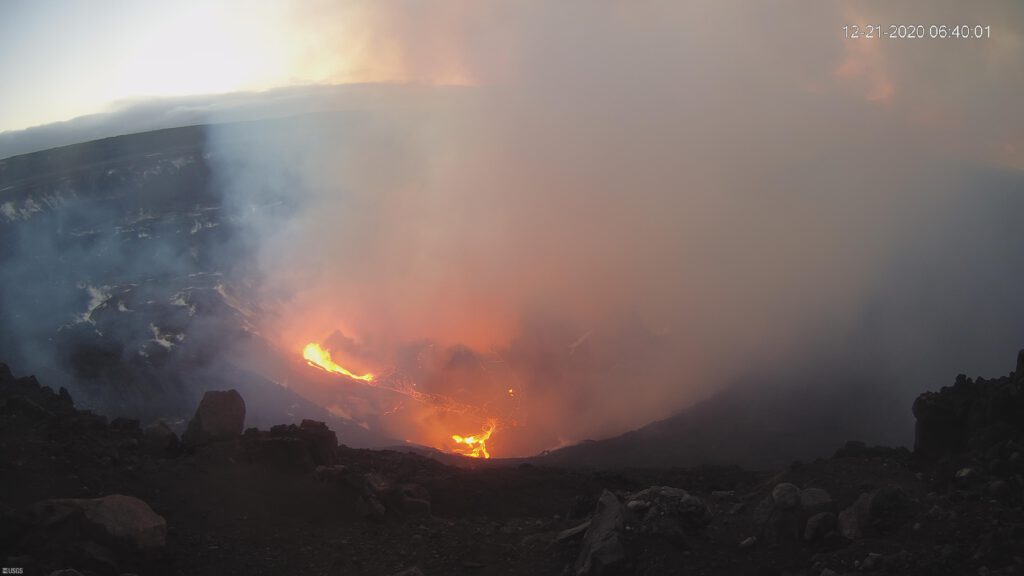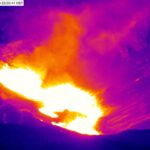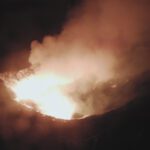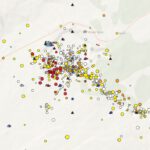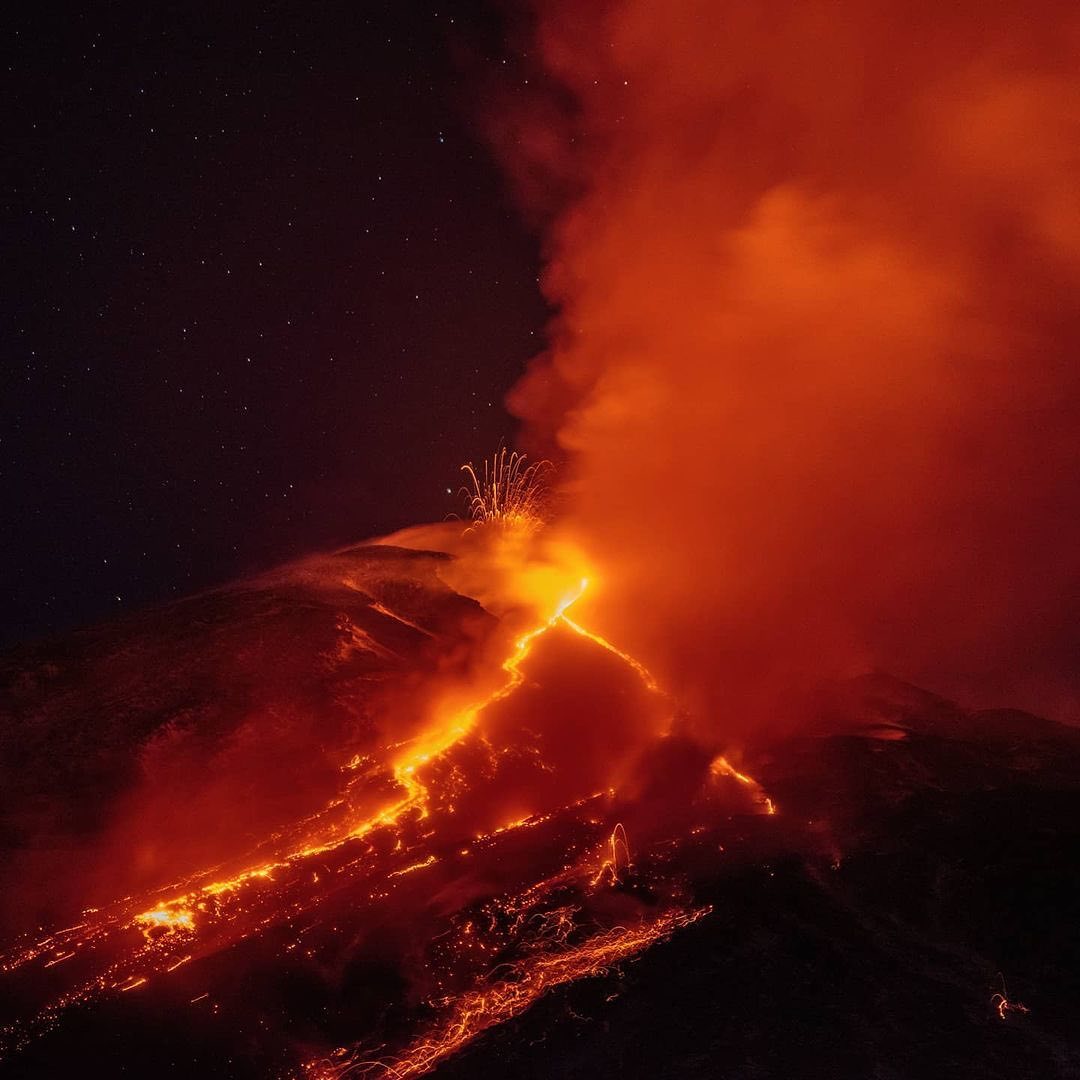At Etna in Sicily, activity increased again at night. INGV reported an increase in strombolian activity. Around 02:50 (UCT), at least 2 vents of Southeast Crater were active. Then, at 03:15, lava began flowing again from the vent in the southwest flank of the crater. A little later, the inclinometers indicated ground deformation in the form of inflation. Tremor amplitude increased significantly and another paroxysm began. 2 lava fountains were generated. Lava flows headed south and east, into the Valle del Bove. There, a phreatic explosion occurred when the lava encountered a large amount of meltwater originating from the snow on the flank. In the morning hours, the activity subsided. Currently, the lava flow in the south is still somewhat active.
Eruptions
News about eruptions and volcanoes can be found in this category. It is updated frequently. Volcano expert and journalist Marc Szeglat reports live from his expeditions to volcanoes.
Kilauea builds a lava lake
The eruption at Kilauea continues, but the rate of production has decreased. Lava still flows from the crack in the crater wall, feeding a growing lava lake. At the rim, the lava remains molten; at the center, it is cooling. Whether the lake can sustain itself in the long term depends on whether it manages to flood the vent. Then only comparatively little lava needs to flow in to keep the whole system going. Of course, there must also be circulation, and lava must be able to flow out again. In the past, lava flowed out of the caldera toward Puʻu ʻŌʻō.
The HVO graded Kilauea to “yellow” alert status. An “orange” alert level is in effect for air traffic. Phreatomagmatic eruptions are apparently still considered possible, which could produce high rising ash clouds.
Etna: New paroxysm on 21.12.2020
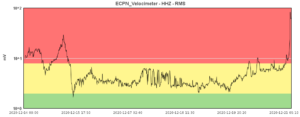 Not only Kilauea is giving full throttle today, but also Etna. In these minutes, another paroxysm is taking place! Largely hidden in the clouds, though. But the tremor is clear. Judging by the amplitude, the current paroxysm should be a lot stronger than the one from December 13. Already last night there was strombolian activity and increasing tremor. It really looks like Etna has entered a new phase with paroxysms.
Not only Kilauea is giving full throttle today, but also Etna. In these minutes, another paroxysm is taking place! Largely hidden in the clouds, though. But the tremor is clear. Judging by the amplitude, the current paroxysm should be a lot stronger than the one from December 13. Already last night there was strombolian activity and increasing tremor. It really looks like Etna has entered a new phase with paroxysms.
Kilauea: Eruption on 21. December 2020
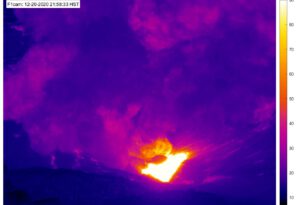 At Kilauea in Hawaii an eruption has apparently started today! On various livecams you can see bright luminous phenomena coming from the Halemaʻumaʻu crater. Included here is a live image from the ThermalCam. I am collecting more information and stay tuned with new information!
At Kilauea in Hawaii an eruption has apparently started today! On various livecams you can see bright luminous phenomena coming from the Halemaʻumaʻu crater. Included here is a live image from the ThermalCam. I am collecting more information and stay tuned with new information!
Update 10:00 a.m.: Although official reports from volcanologists are still pending, it is safe to assume that a new volcanic eruption has indeed begun on Great Conjunction Day. All live cams with a view of the summit caldera show red illuminated steam clouds rising from the Halemaʻumaʻu crater. In addition, seismicity is significantly elevated, although without a massive seismic crisis. It is likely that the magma is leaking that intruded earlier this month and caused inflation of 12-14 µrad.
What happened to the crater lake is unclear so far. Strong phreatomagmatic eruptions do not seem to have occurred so far. Maybe it simply expired before, or evaporated.
On the thermalcam you can see that right now a new vent has opened in the crater slope and lava is being erupted. The situation is very dynamic! A new lava lake could be formed.
Klyuchevskoy: Spectacular photo
Klyuchevskoy on Kamchatka is still active, but the strength of the eruption decreased significantly. Currently, no more lava flow is erupted. However, there are strombolian eruptions covering the summit area with incandescent tephra. MIROVA is receiving a moderate thermal signal with a power of 112 MW.
A photo was shared in our FB group, taken by Russian adventurer Anastasia Tsareva. Before the lava flow dried up, she, together with her friend, climbed the flank of the volcano and moved about 2000 m away from the base camp, which I assume means elevation meters. The two of them did not dare to climb any further, because numerous rockfalls were coming towards them. At least they reached the edge of the lava flow and could deliver fantastic photographs.
Etna: Unexpected paroxysm
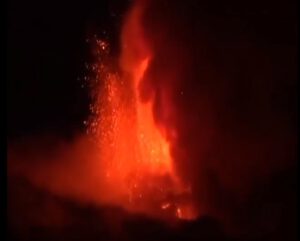 Mount Etna in Sicily erupted unexpectedly last night, producing a paroxysm. The eruption began at 9:20 p.m. and increased to a full-blown paroxysm within half an hour. A lava fountain several hundred meters high was produced, feeding a lava flow that has not now completely stopped. VAAC recorded volcanic ash at 4900 meters above sea level. MIROVA recorded a very strong thermal radiation with a power of 6088 MW. According to an INGV report, the lava did not originate from the lava fountain alone, but 2 fissures also opened on the south side of the New Southeast Crater cone. In the course of the crack opening, 3 pyroclastic flows went off and a 2nd lava flow was created. Lava flowed in the gap between the Barbagallo and Monte Supino cinder cones. This was also the path taken by the flows during some of the last eruptions. How far the front descended has not yet been communicated. Volcanologists observed a fast inflation and the slope increased by 0.1 microrad. At 10:50 p.m., the explosions subsided again and the tremor decreased. Until now, however, it is still moderately elevated.
Mount Etna in Sicily erupted unexpectedly last night, producing a paroxysm. The eruption began at 9:20 p.m. and increased to a full-blown paroxysm within half an hour. A lava fountain several hundred meters high was produced, feeding a lava flow that has not now completely stopped. VAAC recorded volcanic ash at 4900 meters above sea level. MIROVA recorded a very strong thermal radiation with a power of 6088 MW. According to an INGV report, the lava did not originate from the lava fountain alone, but 2 fissures also opened on the south side of the New Southeast Crater cone. In the course of the crack opening, 3 pyroclastic flows went off and a 2nd lava flow was created. Lava flowed in the gap between the Barbagallo and Monte Supino cinder cones. This was also the path taken by the flows during some of the last eruptions. How far the front descended has not yet been communicated. Volcanologists observed a fast inflation and the slope increased by 0.1 microrad. At 10:50 p.m., the explosions subsided again and the tremor decreased. Until now, however, it is still moderately elevated.
Karymsky: Update 10.12.2020
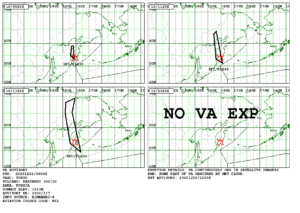 In Kamchatka, Russia, the remote Karymsky volcano erupted today. VAAC issued 4 VONA warnings about Karymsky since yesterday. The satellites detected volcanic ash at an altitude of 7600 m. Ash clouds drifted in a northerly direction. KVERT warns that eruptions may occur at any time, and their eruption clouds may pose a hazard to air traffic.
In Kamchatka, Russia, the remote Karymsky volcano erupted today. VAAC issued 4 VONA warnings about Karymsky since yesterday. The satellites detected volcanic ash at an altitude of 7600 m. Ash clouds drifted in a northerly direction. KVERT warns that eruptions may occur at any time, and their eruption clouds may pose a hazard to air traffic.
Fuego: Update 09.12.2020
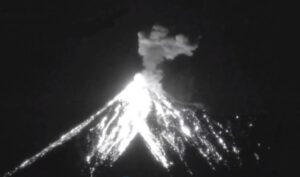 Guatemalan volcano Fuego increased its activity in recent days in terms of frequency of explosive eruptions. The latest update from INSIVUMEH states that volcanologists registered between 8 and 15 explosions per hour. In previous weeks, a maximum of 12 eruptions were observed. In addition, some explosions are stronger than in previous days. In some cases, so much tephra is ejected that debris avalanches are formed. Incandescent tephra reaches the edge of vegetation and can start fires. VAAC reported volcanic ash at an altitude of 4600 m.
Guatemalan volcano Fuego increased its activity in recent days in terms of frequency of explosive eruptions. The latest update from INSIVUMEH states that volcanologists registered between 8 and 15 explosions per hour. In previous weeks, a maximum of 12 eruptions were observed. In addition, some explosions are stronger than in previous days. In some cases, so much tephra is ejected that debris avalanches are formed. Incandescent tephra reaches the edge of vegetation and can start fires. VAAC reported volcanic ash at an altitude of 4600 m.
Popocatepetl: New ash eruptions
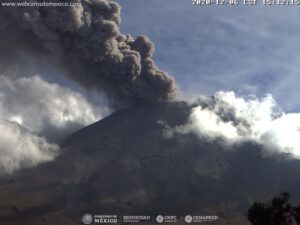 In Mexico the Popocatepetl is still active and has produced 4 ash clouds since yesterday. They reached an altitude of up to 6700 m and drifted towards the northeast. On nightly photos it can be seen that red glowing tephra was erupted, which fell down on the volcano flanks. CENAPRED also reported 93 ash-steam exhalations, 448 minutes of tremors and 2 volcano-tectonic earthquakes. So it seems that more magma is rising again and further activity must be expected. The explosions could increase.
In Mexico the Popocatepetl is still active and has produced 4 ash clouds since yesterday. They reached an altitude of up to 6700 m and drifted towards the northeast. On nightly photos it can be seen that red glowing tephra was erupted, which fell down on the volcano flanks. CENAPRED also reported 93 ash-steam exhalations, 448 minutes of tremors and 2 volcano-tectonic earthquakes. So it seems that more magma is rising again and further activity must be expected. The explosions could increase.
Piton Fournaise: eruption on 07 December
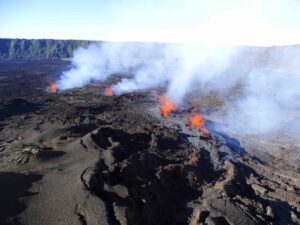 Tonight began the long-awaited eruption of the Piton de la Fournaise on La Réunion. At 04:40 (local time) volcanic quakes occurred, which marked the beginning of the eruption. Prior to this, there was a seismic crisis lasting more than 2 hours, which was accompanied by rapid ground deformation. It was caused by the magma rise. The volcanologists of the OVPF flew with the helicopter to the eruption site and were able to locate the eruption fissures exactly. Over a total distance of about 700 m three fissures opened. They are located on the west-southwestern flank of the volcano, at an altitude between 2300 and 2190 m. At the time of the overflight, between 7:00 and 7:30 local time, the three fissures were active and ejected lava fountains about 15 meters high. They fed a lava flow. The flow front spread only slowly and was at about 2120 m altitude.
Tonight began the long-awaited eruption of the Piton de la Fournaise on La Réunion. At 04:40 (local time) volcanic quakes occurred, which marked the beginning of the eruption. Prior to this, there was a seismic crisis lasting more than 2 hours, which was accompanied by rapid ground deformation. It was caused by the magma rise. The volcanologists of the OVPF flew with the helicopter to the eruption site and were able to locate the eruption fissures exactly. Over a total distance of about 700 m three fissures opened. They are located on the west-southwestern flank of the volcano, at an altitude between 2300 and 2190 m. At the time of the overflight, between 7:00 and 7:30 local time, the three fissures were active and ejected lava fountains about 15 meters high. They fed a lava flow. The flow front spread only slowly and was at about 2120 m altitude.
